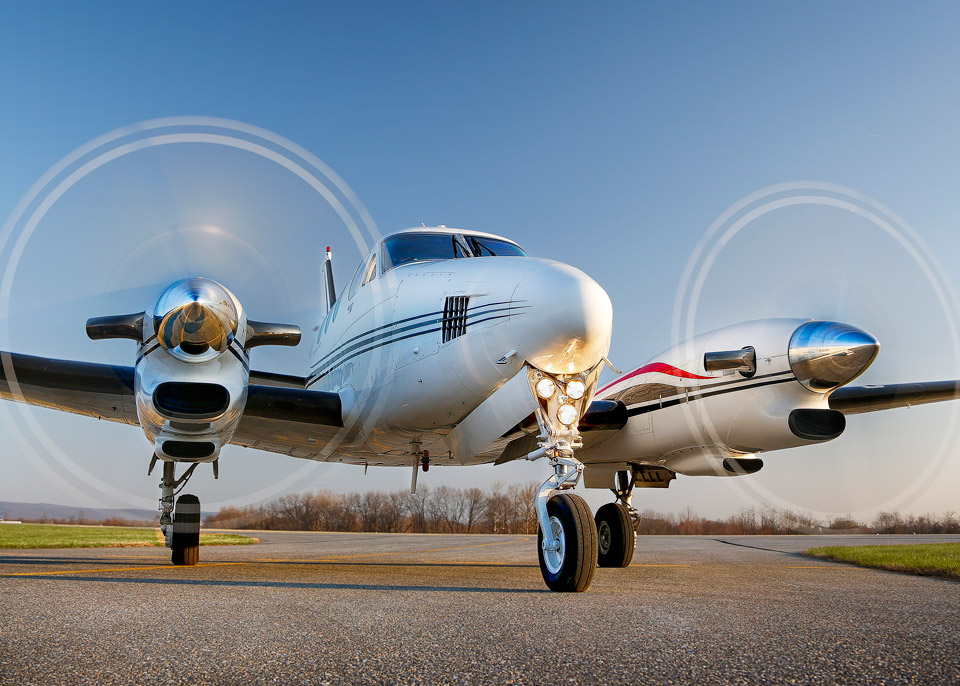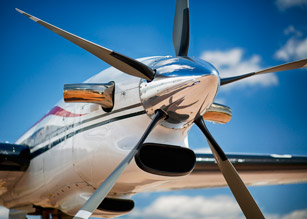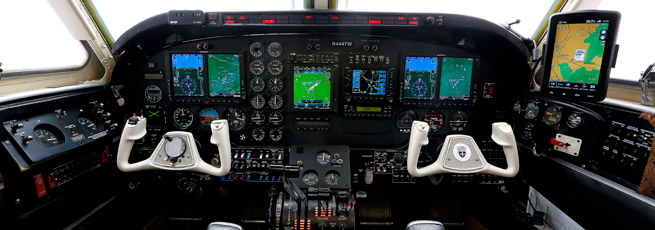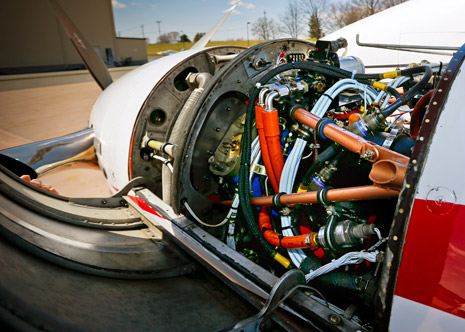
Photography by Chris Rose
The eventual pairing of a capitalist King Air C90 made in the American heartland with engines designed and built behind the Iron Curtain would have been hard to imagine at the time they both were originally designed.
But the world has changed so much that one King Air, N4445W, which was made in Wichita during the depths of the Cold War in the 1970s, is now flying with engines and props built in the former Eastern Bloc (installed under an STC by Smyrna Air Center in Middle Tennessee). The updated airframe matched with a pair of 800-horsepower engines seems to provide the best of both worlds: Western refinement and Eastern ruggedness.

“I looked at all the options of new and refurbished aircraft and this one stood out as being head and shoulders above the rest,” said Curt Drumm, owner of Lakeshore Aviation in Manitowoc, Wisconsin, an air charter operator who recently took delivery of this first King Air to undergo the Power90 conversion. “It has as much or better performance than a new airplane at a fraction of the cost. Now that it’s part of our Part 135 fleet, I know our customers will love it.”
Walter Engines was just beginning to manufacture turboprops in Prague, capital of what’s now the Czech Republic, in the mid-1970s when N4445W was built half a world away in Wichita. The Cold War already had been a reality for almost 30 years then, and it would continue for another two decades. Walter’s 650-shaft-horsepower M601 engine turned out to be a rugged standout that eventually came to power dozens of Eastern Bloc aircraft designs including agricultural airplanes, military transports, and regional airliners.
Jump ahead to the collapse of communism; American giant General Electric purchased Walter and, with it, the rights to the M601. By then, the M601 had logged millions of flight hours and had a reputation for reliability in harsh climates from Siberia to the Sahara. GE engineers spent several years reworking the internal components of the M601 to make it more efficient and increase its power.
The result is the GE H80, an 800-shaft horsepower remake that was first FAA certified in the United States last year on a Thrush 510G ag airplane, and it’s now moving to the general aviation fleet (“Czechered Past,” May 2013 AOPA Pilot). The engines are still manufactured in Prague, and Smyrna Air Center obtained an STC for 90-model King Airs (C90, A90, B90, and E90).
AOPA Pilot recently flew the refurbished aircraft with Lakeshore Aviation’s Drumm, and the changes from the original airplane were noticeable as soon as it appeared on the AOPA ramp. Five-blade, scimitar-shaped Avia propellers now pull the aircraft along, and each engine cowl has two air intakes: one to feed the engine and a smaller one for the oil cooler.
The props themselves have shifted about 6 inches forward for weight and balance considerations. (The H80 engines are lighter than the Pratt & Whitney PT6As they replace.) In fact, the prop discs are so far forward they are almost flush with the tip of the King Air’s radome. This particular airplane also has Raisbeck wing lockers (which aren’t part of the engine STC) and Raisbeck dual aft body strakes (which are).
Other changes are more than skin-deep. The conversion involves full inspections (phase one through four) and all life-limited airframe parts are brought to zero time. New H80 engines replace the old ones (typically PT6A-21s rated at 550 shp), and the Avia props are added.

The instrument panel also is transformed. N4445W received dual Garmin G600 PFD/MFDs, a GTN 750 and GNS 530W, GWX/70 color radar, and a GTX/330ES transponder that provides ADS-B Out. Interestingly, the cockpit also has a portable but hardwired GPSMAP 750 and GDL 39 that provides ADS-B In subscription-free weather and traffic.
But the engines are the biggest change—and the main selling point.
The H80 has a 3,600-hour TBO (6,600 cycles) and doesn’t require any nozzle or hot-section inspections during normal service. Instead of fuel nozzles, a slinger ring distributes fuel to the combustion chamber.
“The lack of nozzle and hot-section inspections alone will save more than $200,000 in maintenance costs and an untold amount of downtime during the lives of these engines,” Drumm said. “The money and the time savings are huge considerations for a charter operator like us.”
N4445W had logged about 100 flight hours since the conversion when it arrived at AOPA headquarters, and Drumm downloads data from every flight and sends it to GE engineers for analysis.
Drumm said the biggest advantage is improved climb performance, and that enhances speed and efficiency by allowing the airplane to spend more time at high altitudes—where true airspeeds are higher and fuel burn is lower.
At gross weight, Smyrna Air Center claims an H80-equipped C90 can reach FL280 in 17 minutes, climbing at a best rate of 130 KIAS. In normal operations, Drumm said it typically takes him about 23 minutes to climb to FL250 at a cruise climb of 150 KIAS.
“The rate of climb is exceptional,” he said. “We can climb at 1,300 to 1,500 fpm into the mid-20s.” (N4445W isn’t RVSM equipped, so it isn’t allowed above FL280.)
At FL250, redline torque (1,380 foot pounds), and max prop rpm (1,900), the airplane typically delivers 255 KTAS while burning 88 gph (590 pph) of jet fuel, according to Drumm’s data. At the same altitude, economy cruise and 1,800 prop rpm nets 238 KIAS at 74.5 gph (500 pph).
Above FL250, the 740-degree ITT redline limits power.
“We expect excellent hot-and-high performance,” Drumm said. “But I live in Wisconsin and took delivery of the airplane in the middle of winter, so I haven’t seen that yet.”

The biggest change that pilots will notice about the H80 is the automated start sequence. With electrical power on (and voltage checked), the pilot simply moves the condition lever to idle (there’s no flight or ground idle) and pushes the start button. If the computerized engine monitor senses temperatures or pressures rising at abnormal rates, it diverts fuel from the engine to avoid damage from a hot start.
Once the 20-second start sequence is complete and the props are moved out of the feather position, the rest of the C90 checklist is unchanged.
Our demo flight took place on a 30-degree-Fahrenheit morning with calm surface winds. N4445W carried a relatively light load of four people and about 250 gallons of fuel. Initial acceleration was brisk, and we quickly caught up with the Mooney that served as our photo ship.
Handling qualities are unchanged from the refined mix of stability and control harmony that have been King Air hallmarks for a half century. And even though the props have moved forward, there’s no noticeable change in visibility.
The cabin noise level seems reduced as a result of the five-blade props, but there was no way to quantify that on our flight.
In summary, the GE-equipped Power90 King Air appears to offer a compelling value to customers seeking a refurbished airframe and performance gains, but GE’s commitment to general aviation is as yet unproven. The company has talent, resources, and staying power, and its jet engines set high standards in military aircraft and airliners. Hopefully, the company will take a long-term approach to GA and build the necessary parts, maintenance, and customer support networks that the GA market requires.
If so, the H80 could be the first in an entire family of new turboprops to power both new and retrofit airframes. GA manufacturers and aircraft owners stand to benefit from heightened competition, and demand for products made in places such as Wichita and Prague can grow. That may seem fanciful, but it’s not nearly as outlandish as the notion of East and West flying harmoniously together on a King Air would have been in the 1970s.
Email [email protected].
SPEC SHEET
King Air Power90
Base price: $1,895,000
SPECIFICATIONS
Includes two new GE H80 engines, two new Avia 5-blade propellers, Garmin avionics, new or like-new paint and interior, warranty on the engines, props, and avionics, available financing from GE Finance, and available GE OnPoint (power by the hour) program.
Powerplant | General Electric H80
Shaft horsepower (per engine) | 800 hp
Recommended TBO | 3,600 hrs
Length | 35.5 ft
Height | 14.3 ft
Wingspan | 50.3 ft
Cabin Length | 12 ft 8 in
Cabin Height | 4 ft 8 in
Cabin Width | 4 ft 8 in
Crew | 1
Passengers | 7
Pressurization (psi) | 5.0
Weight | 3,176 lbs
Fuel capacity standard | 474 gal
Max ramp weight | 10,160 lbs
Max takeoff weight | 10,100 lbs
Zero fuel weight | 9,074 lbs
Basic operating weight | 6,452 lbs
Max landing weight | 9,700 lbs
PERFORMANCE
VSO landing | 77 kts
Normal cruise TAS | 260 kts
VMO (Max op) IAS | 226 kts
Normal climb | 1,870 fpm
Engine out climb | 470 fpm
Ceiling | 30,000 ft
Range | 1,375 nm
Hot section interval | None required
Fuel nozzle interval | None required
For more information, visit the website.



